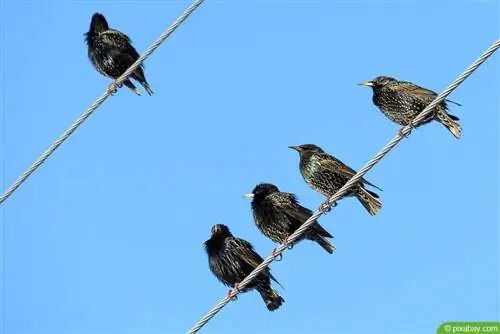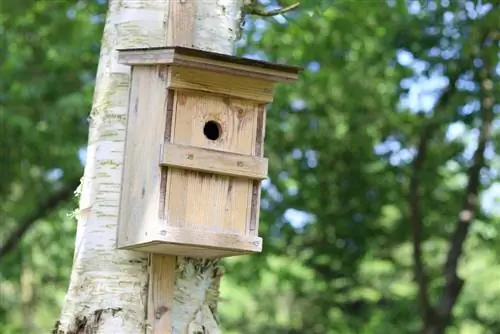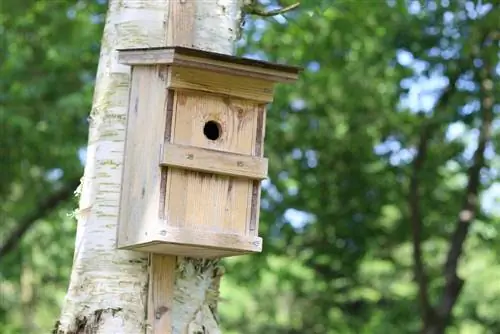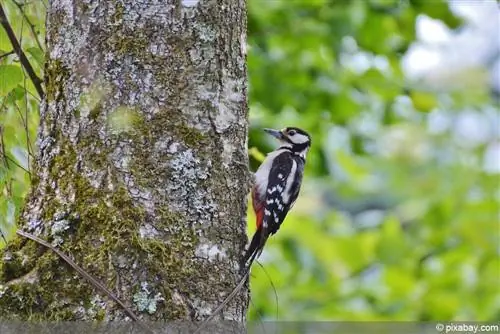- Author admin [email protected].
- Public 2023-12-17 03:39.
- Last modified 2025-01-24 12:45.
Sonorous melodies and a he althy appetite for pests - the robins are a big asset despite their small size. And not just in the garden, but also on the balcony. However, in order for them to feel really comfortable and to keep insects away, they need sufficient protection and food.
This also applies to winter. Bird lovers, hobby gardeners and all other interested parties will find out below which measures are recommended or even necessary for caring for robins.
Profile
- Family: Flycatcher
- Scientific name: Erithacus rubecula
- Distribution: Europe, North Africa, Asia Minor, Mediterranean islands
- Distinctive feature: orange-red coloring from forehead to chest
- Size: 13.5 to 14 cm
- Weight: 15 to 18 grams
- Gender determination: no visual differences, only recognizable by behavior during courtship
- Wingspan: up to 22 cm
- Food: insects, spiders, worms, fewer seeds and fruits
- Enemies: cats and martens, birds of prey such as sparrowhawks and falcons, humans
- Threat: not considered endangered
- Singing: mostly at dusk, extremely variable
- Nesting sites: cup-shaped nest, close to the ground, in dense vegetation
- Migratory bird: robin populations living in Northern and Eastern Europe move to warmer climes from October onwards
- Life expectancy: about 5 years
- Reproduction: two egg layings of about 6 each between April and July
Benefits in the garden
Since the robin feeds primarily on insects, larvae, worms and smaller spiders, it can do a good job in the garden and contributes to plant protection. Anyone who is lucky enough to find one or more robins in their own green area should welcome them. With a suitable nesting box, protection from predators and help with finding food, this is quite easy to achieve in the long term.
Activity
The robin is one of the early birds. Its singing, which is noticeably variable, can be heard even before sunrise. But the robin can also make itself heard in the evening twilight. When other bird species sing, however, it is heard less often. The representatives of the flycatchers usually wait for quieter times. In urban areas, this can happen long after dusk.
Feeding
If you want to welcome the robins into the garden and make breeding easier for them, you have to provide enough food. If the environment is not rich in insects, the small birds with brightly colored breasts will not show themselves and certainly will not breed. Natural gardens with dense hedges and undergrowth are ideal. The following tips can help you design your own green space appropriately:
- let the plants grow wild in at least one corner
- do not use pesticides
- Only trim hedges outside of the breeding season
- create a wild, natural meadow in a robin-friendly area
- never mow all the meadows at the same time
- Leave piles of leaves or brushwood lying around
- create a natural garden pond
- Use magi and nectar plants
Thanks to these small changes, the robins find numerous insects during the spring and summer and can eat them safely thanks to the relative protection of the dense design. In addition, it makes sense to put some plants in the garden, which the robin also feeds on or where it can hide wonderfully. These include:
- Privet
- Daphne
- Dogwood
- Whiteberries
- Robin Bread
- Blackberries
- rotten tree
- elderberry
- Pfaffenhütchen
- Snowball
- Ivy
Care in autumn and winter
Not all robins are migratory birds in temperate climates. However, to avoid significant reductions in the bird population during particularly harsh winters, they still need reliable sources of food. In natural gardens, these arise naturally. Piles of leaves, undergrowth and brushwood harbor insects and thus provide food for robins. However, in cities, very long winters or more decorative gardens, the birds have a difficult time. Therefore, supplementary feeding should be provided in any case.
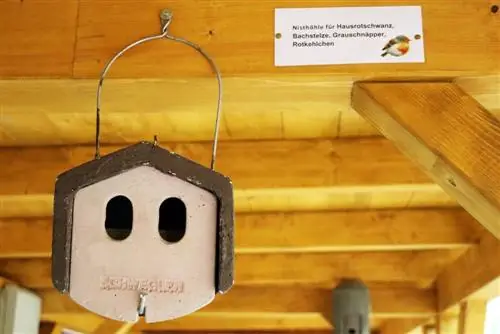
In order to get the birds used to it in good time, it makes sense to set up a suitable feeding place at the end of the summer. This should be close to the ground but protected so that the robins are at least safe from cats and martens. The following tips help with this protection and for setting up feeding:
- Sprinkle food directly onto the snow-free ground, for example on a board.
- Define the feeding area all around with wire mesh, bend the wire outwards at the top end.
- Alternatively, use a bird feeder with a large, flat base plate or convert the window sill into a feeding place.
- Choose food for insectivores that contains mealworms, ant pupae and other protein sources.
- Mix in the nut slivers and cereal flakes.
In the garden, scatter food in places that normally harbor insects - such as on piles of sticks and leaves, under hedges and in the undergrowth
If you have already gotten the robins used to the additional feeding and observe them every day at a certain time, you can go one step further and use fresh, still-living mealworms from the pet trade. However, these must be absorbed quickly. If they freeze, it can be dangerous for the robins.
Courtship behavior and breeding times
From March onwards, a female robin moves into the territory of a male and initially behaves placatingly. After a few days, the male stops his defensive behavior and the couple protects his area together. After courtship, everything happens pretty quickly. An open, bowl-shaped nest is built within a few days and is padded with feathers, hair and other soft materials. The female lays around six eggs and incubates them for 14 days, usually alone. Meanwhile, the male robin provides food. The young birds hatch after two weeks and need another 14 days until they fledge. Even after this, they still beg for food from their parents and follow them.
As soon as the nest is free again, the parents will breed again. Between April and July, robins usually lay two eggs.
Nestbox
The robins prefer to breed in dense vegetation, for example in hedges and thorny bushes, very close to the ground. Nests are rarely found above two or three meters in height. In cities they make do with holes and half-caves in walls and on the walls of houses. Nesting boxes can also be used here. These are popular when hung in hedges, blackberry bushes, under eaves or on ivy-covered walls if they meet the following requirements:
- half-open shape or large entrances
- protected from rain
- durably manufactured, ideally made of wood
- Openings kept too small for cats, birds of prey and martens
- clean and empty inside, the robins themselves provide the nesting material
So-called half-cave breeders were used for robins for a long time. Due to their very open shape, the birds are happy to accept them, but unfortunately this design also offers easy access to enemies. A nesting box that has oval holes is therefore preferable. These should measure approximately 3 x 5 cm. Tip: A nesting box that opens to the side is ideal for cleaning, which should be carried out at the end of summer or in autumn. So the box is ready for the next breeding season.
Cat Protection
To protect against predators, it is advisable to separate the nesting box and feeding area from the outside with wire mesh or spikes. Thorny bushes, thick hedges and smooth walls are also favorable.
Conclusion
If the robin is to be used as a helper in the garden or simply to keep the area in front of the windows free of insects, only a few measures are necessary. Even if you just want to observe your feathered friends, you can optimally design the habitat for them with little effort.
What you should know about robins in brief
- Robins lay their nests in appropriate niches in rock faces, scree slopes, buildings, trees and embankments.
- Special nesting aids were developed for the birds - the niche breeding box.
- The most famous is the so-called half cave, which is half open at the front. It has the disadvantage that it is easily accessible to nest robbers.
- That's why a new nesting box was developed. This now has two oval entry holes measuring approx. 32 x 50 mm.
- There are also nesting boxes that have a special extended stem. These nesting boxes can therefore be hung freely.
- The half cave has an additional breeding chamber insert. Even on dark slopes, the entrance opening provides good light.
- Robin nesting boxes should be installed at a height of 2 to 3 meters. The best place is under an eaves in partial shade.
- The opening must, if possible, face away from the house and be difficult for cats and martens to reach.
- It is important to clean the nesting box once a year. The best time for this is the end of September and October.
- Robins also like to breed in piles of brushwood and in roots. Tree cavities, wall holes and other caves are also accepted.
- Sometimes nests are built in cans, pots, buckets, watering cans and shoes at rubble dumps and garbage dumps.


